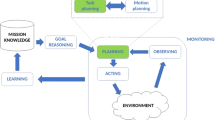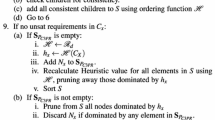Abstract
An intelligent robotic system must be capable of making the best decision at any given moment. The criteria for which task is “best” can be derived by performance metrics as well as the ability for it to satisfy all constraints upon the robot and its mission. Constraints may exist based on safety, reliability, accuracy, etc. This paper presents a decision framework capable of assisting a robotic system to select a task that satisfies all constraints as well as is optimized based upon one or more performance criteria. The framework models this decision process as a constraint satisfaction problem using techniques and algorithms from constraint programming and constraint optimization in order to provide a solution in real-time. This paper presents this framework and initial results provided through two demonstrations. The first utilizes simulation to provide an initial proof of concept, and the second, a security robot demonstration, is performed using a physical robot.
Similar content being viewed by others
References
Akers EL, Stansbury RS, Agah A (2006) Long-term survival of polar mobile robots. In: Proceedings of the 4th international conference on computing, communications and control technologies, Orlando, FL, 20–23 July 2006, vol II, pp 329–333
Bartak R (1999) Constraint programming: in pursuit of the holy grail. In: Proceedings of the week of doctoral students (WDS99), Prague, June 1999
Borning A (1981) The programming language aspects of ThingLab, a constraint-oriented simulation laboratory. ACM Trans Program Lang Syst 3(4): 353–387
Center for Astrophysical Research in Antarctica (2009) Current south pole weather data, obtained through the internet: http://www.astro.uchicago.edu/cara/southpole.edu/weather2.html, [accessed 21/12/2009]
Chun HW, Wong RYM (2004) CLSS: an intelligent crane lorry scheduling system. Appl Intell 20(2): 179–194
Dechter R (1991) Constraint networks. In: Shapiro SC (eds) Encyclopedia of artificial intelligence. Wiley, New York, pp 276–285
Deris S, Omatu S, Ohta H, Samat P (1997) University timetabling by constraint-based reasoning: a case study. J Oper Res Soc 48(12): 1178–1190
Georget Y (2009) Koalog constraint solver: fast constraint solving in Java, obtained through the internet: http://www.informaticians.org/fjcp2004/slides/georget/nii041025.pdf [accessed 21/12/2009]
Gogineni S, Prescott G, Braaten D, Allen C (2003) Polar radar for ice sheet measurements. In: Proceedings of the international geoscience and remote sensing symposium, Toulouse, France, 21–25 July, vol 3, pp 1607–1609
IBM (2009) IBM ILOG CP, obtained through the internet: http://www-01.ibm.com/software/integration/optimization/cp1/ [accessed 21/12/2009]
Kumar V (1992) Algorithms for constraint satisfaction problems: a survey. AI Mag 13(1): 32–44
Lever J, Streeter A, Ray L (2006) Performance of a solar-powered robot for polar instrument networks. In: Proceedings of the 2006 international conference on robotics and automation, Orlando, FL, 15–19 May 2006, pp 4252–4257
Mackworth AK (1997a) Consistency in networks of relations. Artif Intell 8(1): 99–118
Mackworth AK (1997b) Constraint-based design of embedded intelligent systems. Constraints 2: 83–86
Mobile Robots Inc (2009) AmigoBot robot for education and collaborative research, obtained through the internet: http://www.activrobots.com/ROBOTS/amigobot.html [accessed 21/12/2009]
Pai DK (1989) Programming parallel distributed control for complex systems. In: IEEE international symposium on intelligent control, Albany, NY, 25–26 Sept 1989, pp 426–432
Pai DK (1991) Least constraint: a framework for the control of complex mechanical systems. In: The American control conference, Boston, MA, 26–28 June 1991, pp 615–621
Ray L, Price A, Streeter A, Denton D, Lever JH (2005) The design of a mobile robot for instrument network deployment in Antarctica. In: Proceedings of the 2005 international conference on robotics and automation, Barcelona, Spain, 18–22 April 2005, pp 2111–2116
RidgeSoft LLC (2009) Intellibrain-Bot educational robot. Obtained through the internet: http://www.ridgesoft.com/intellibrainbot/intellibrainbot.htm [accessed 21/12/2009]
Russel S, Norvig P (2002) Artificial intelligence: a modern approach. 2. Prentice Hall, Upper Saddle River
Stansbury RS (2007) Constraint-based task selection and configuration for autonomous mobile robots, Ph.D. dissertation, University of Kansas, Lawrence, KS, July 2007
Stansbury RS, Agah A (2008) Autonomous mobile robot task selection and configuration using constraint satisfaction. In: Proceedings of the international conference on automation, robotics, and control systems, Orlando, FL, 7–10 July 2008, pp 103–109
Stansbury RS, Akers EL, Harmon HP, Agah A (2004) Survivability, mobility, and functionality of a rover for radars in polar regions. Int J Control Autom Syst 2(3): 334–353
Syrjanen M (1998) Production management as a constraint satisfaction problem. J Intell Manuf 9: 515–522
Tsang E (1993) Foundations of constraint satisfaction. Academic Press, London
Zhang Y, Mackworth AK (1994) Will the robot do the right thing? In: Proceedings of artificial intelligence, Banff, AB, May 1994, vol 138, pp 255–262
Zhang Y, Mackworth AK (2005) A constraint-based robotic soccer team. Constraints 7: 7–28
Author information
Authors and Affiliations
Corresponding author
Rights and permissions
About this article
Cite this article
Stansbury, R.S., Agah, A. A robot decision making framework using constraint programming. Artif Intell Rev 38, 67–83 (2012). https://doi.org/10.1007/s10462-011-9241-y
Published:
Issue Date:
DOI: https://doi.org/10.1007/s10462-011-9241-y




